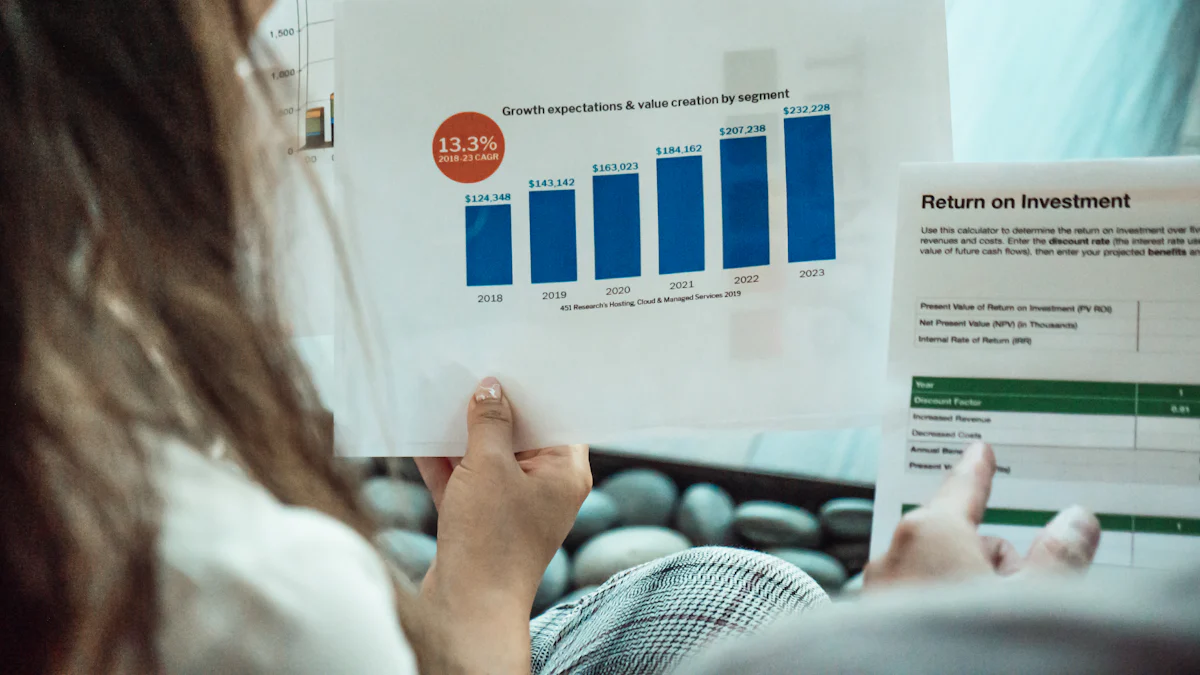Top Strategies to Maximize ROI in Influencer Marketing

Maximizing the ROI on influencer marketing is no longer optional—it’s essential. With businesses earning an average of $6.50 for every $1 spent, the potential for growth is undeniable. Some brands even achieve an ROI of $20 or more, proving that the right approach can deliver extraordinary results. You can’t afford to leave this kind of value untapped. By focusing on influencer marketing ROI, you justify your investment with measurable outcomes and uncover opportunities to refine your strategy. When you align your campaign goals with the right influencers, you build trust with audiences and drive conversions like never before.
💡 Did you know? Combining influencer marketing with paid amplification allows you to target your ideal customers more precisely, boosting your chances of success.
Choosing the Right Influencers

Finding the right influencers is the cornerstone of successful influencer marketing. When you partner with influencers who align with your brand and resonate with your target audience, you create authentic connections that drive results. Here’s how you can identify the perfect match for your influencer campaigns.
Aligning Influencers with Brand Values
Your brand values are the foundation of your identity. To maximize influencer marketing ROI, you need influencers who share those values. Misaligned partnerships can feel forced and inauthentic, which your audience will notice. Start by reviewing an influencer’s content to understand what motivates them. Does their messaging reflect your brand’s ethos? For example, Gymshark excels at this by choosing influencers from its fitness community, ensuring alignment with its active lifestyle image.
To ensure a strong fit, follow these steps:
- Look for consistency in the influencer’s messaging and values.
- Research their niche to confirm relevance to your product or service.
- Examine their content quality and style for compatibility with your brand.
- Analyze their audience demographics to ensure alignment with your target audience.
- Review past partnerships to assess their ability to represent brands authentically.
- Evaluate engagement rates and audience sentiment to gauge their influence.
- Communicate directly with the influencer to discuss expectations and mutual interest.
Evaluating Audience Engagement and Demographics
Engagement rates are a critical metric in influencer marketing strategies. High engagement shows that an influencer’s audience is active and genuinely interested in their content. Use tools like Instagram Insights or YouTube Analytics to access demographic data and engagement metrics. Third-party platforms like Upfluence or Modash can also provide detailed audience analysis. These tools help you confirm that the influencer’s followers align with your target audience.
Additionally, consider using surveys or polls to gather direct feedback from the influencer’s audience. This approach ensures you’re reaching the right people with your influencer campaigns.
Assessing Credibility and Authenticity
Credibility is non-negotiable in influencer marketing. An influencer’s authenticity directly impacts how their audience perceives your brand. Watch for red flags like sudden spikes in follower counts, which may indicate fake followers. Low engagement rates despite a large following can also signal inauthenticity. Authentic influencers grow their audience gradually and maintain strong connections through relatable, personalized content.
For example, influencers who share genuine stories about how your product fits into their lives build trust with their followers. Avoid influencers who simply regurgitate product details without adding their unique perspective. Instead, focus on those who create meaningful, engaging narratives.
By carefully evaluating these factors, you can ensure your influencer marketing strategies deliver measurable results.
Leveraging Tools to Identify High-Performing Influencers
Finding high-performing influencers doesn’t have to feel like searching for a needle in a haystack. With the right tools, you can streamline the process and focus on influencers who deliver real results. These platforms provide detailed insights into audience demographics, engagement rates, and past campaign performance, helping you make data-driven decisions.
💡 Pro Tip: Use tools that offer AI-powered analytics to save time and uncover hidden influencer gems.
Here are some of the best tools you can use to identify top-performing influencers:
-
Upfluence
This platform allows you to search for influencers based on keywords, location, and audience demographics. It also integrates with your e-commerce platform to identify influencers already engaging with your brand. -
HypeAuditor
HypeAuditor specializes in detecting fake followers and analyzing audience quality. It provides a credibility score, ensuring you only work with authentic influencers. -
BuzzSumo
BuzzSumo helps you discover influencers by analyzing trending content in your niche. It also tracks their performance metrics, so you can see how well they resonate with their audience. -
Traackr
Traackr offers a comprehensive influencer relationship management system. It tracks campaign performance and helps you build long-term partnerships with influencers. -
NinjaOutreach
This tool simplifies influencer outreach by providing contact information and templates for personalized pitches. It also tracks responses, making it easier to manage collaborations.
🚀 Action Step: Start with free trials of these tools to explore their features and find the one that fits your needs.
Using these tools gives you a competitive edge. You’ll save time, reduce guesswork, and focus on influencers who align with your goals. Don’t leave your ROI to chance—leverage technology to make smarter decisions today.
Aligning Content with Audience Needs
Creating content that resonates with your target audience is essential for successful influencer marketing. When you align your messaging with their preferences, you increase engagement and drive better results. Here’s how you can ensure your content meets audience expectations.
Conducting In-Depth Audience Research
Understanding your audience is the first step to crafting impactful campaigns. Use a combination of methods to gather audience insights:
- Primary research, such as interviews and surveys.
- Social media analytics tools like Instagram Insights or YouTube Analytics.
- Third-party platforms like Phyllo’s universal API for detailed data.
- Focus groups to explore preferences and behaviors.
For example, if you sell clothing locally, conducting interviews about favorite outfits and rising styles can help you tailor your offerings. Evaluate key performance indicators (KPIs) like demographics, psychographics, and buying behavior. This approach ensures your influencer marketing strategies are data-driven and effective.
Tailoring Content to Audience Preferences
Generic content won’t capture attention. You need to create tailored messaging that speaks directly to your audience. Start by analyzing their interests, values, and lifestyle. Use audience insights to identify what resonates most.
One proven strategy is content clustering. For instance, ISSA, a fitness certification provider, creates content that addresses common questions and search intents of its audience. This approach ensures relevance and builds trust. Similarly, you can develop content that aligns with your audience’s needs, making your influencer marketing campaigns more impactful.
Collaborating with Influencers on Creative Concepts
Influencers bring unique perspectives that can elevate your campaigns. Collaborating with them on creative concepts fosters authenticity and innovation. Here’s why this approach works:
- Brainstorming with influencers generates fresh ideas.
- Their insights help craft campaigns that resonate with your target audience.
- Collaboration builds stronger relationships, enhancing credibility.
By involving influencers in the creative process, you ensure the content feels genuine and relatable. This strategy not only improves influencer marketing ROI but also strengthens your brand’s connection with its audience.
Creating Authentic Content
Emphasizing Storytelling to Build Connections
Storytelling is one of the most powerful tools in influencer marketing. When influencers share personal stories, they create emotional connections that inspire and motivate their followers. For example, a travel influencer documenting their adventures with specific gear not only showcases the product but also fosters deeper audience engagement. This approach makes your influencer campaigns feel more relatable and genuine.
You can encourage influencers to weave your brand into their daily lives. Instead of a generic product review, ask them to share how your product solves a problem or enhances their routine. This technique enhances brand authenticity and builds trust. Remember, 69% of consumers trust influencer recommendations more than a brand’s own claims. By focusing on storytelling, you can tap into this trust and drive stronger results.
Encouraging Transparency and Honesty in Campaigns
Transparency is essential in influencer partnerships. Social media users value authenticity and expect influencers to disclose sponsored content openly. When influencers share genuine experiences with your brand, they build trust with their followers. This honesty fosters deeper emotional connections and meaningful interactions.
Encourage influencers to highlight both the strengths and limitations of your product. This balanced approach shows respect for the audience and enhances credibility. Genuine influencers who prioritize transparency are more likely to create lasting relationships with their followers, which benefits your brand in the long run. In fact, 63% of online shoppers are more likely to buy a product recommended by their favorite influencer when the recommendation feels authentic.
Building Long-Term Partnerships with Influencers
Long-term influencer partnerships deliver higher ROI compared to one-off collaborations. These relationships allow influencers to become true ambassadors for your brand, creating consistent messaging that resonates with their audience. For example, Pepsi’s partnership with Beyoncé and Adidas’ collaboration with David Beckham have strengthened their brand images over time.
When you invest in long-term relationships, you gain access to influencers who deeply understand your brand. This familiarity leads to more authentic content and stronger consumer relationships. Authenticity fosters loyalty, and loyal customers are more likely to engage with your brand repeatedly. Prioritize building these partnerships to maximize the impact of your influencer marketing strategy.
Leveraging Data Analytics to Improve Influencer Marketing ROI

Data analytics is your secret weapon for improving influencer marketing ROI. By tracking performance metrics, using advanced tools, and refining strategies based on insights, you can maximize the effectiveness of your influencer campaigns.
Tracking Key Performance Metrics for Campaigns
Tracking the right metrics is essential for measuring campaign effectiveness. Metrics like reach, impressions, and CPM help you evaluate brand awareness. Engagement rate shows how well your content resonates with the audience, while click-through rate and website traffic reveal how effectively influencer campaigns drive potential customers to your site. Conversion rates, such as purchases or sign-ups, measure the tangible impact of your efforts.
| Metric | Description |
|---|---|
| Reach | Total number of unique users who have seen your content. |
| Impressions | Total number of times your content has been viewed. |
| CPM | Cost per thousand impressions, indicating the cost of reaching the influencer's audience. |
| Engagement Rate | Measures interactions like likes, comments, and shares, indicating content value. |
| Click-Through Rate | Percentage of clicks on links in influencer content, showing effectiveness in driving traffic. |
| Website Traffic | Insights from metrics like link clicks and time on site, indicating increased web traffic. |
| Conversions | Successful completion of a goal, showing audience action influenced by the campaign. |
| ROI | Revenue generated from campaigns, measuring overall effectiveness and impact. |
Tracking these metrics ensures you can measure campaign effectiveness and identify areas for improvement.
Using Analytics Tools for Strategic Insights
Analytics tools simplify the process of monitoring influencer marketing strategies. Platforms like Traackr, Aspire, and Meltwater provide advanced insights into campaign performance. These tools track audience demographics, engagement metrics, and competitor analysis, giving you a clear picture of what works. For example, Traackr helps you manage influencer relationships and measure ROI, while Aspire uses AI-powered analytics to track performance. Meltwater offers competitor analysis to help you stay ahead in your niche.
Using these tools allows you to make data-driven decisions, ensuring your influencer marketing strategies remain effective and impactful.
Refining Strategies Based on Data-Driven Decisions
Refining your influencer campaigns based on data insights is key to long-term success. Analyze historical campaign data to identify what resonates with your audience. Regularly audit metrics like Cost per Engagement (CPE) and Cost per Click (CPC) to optimize spend efficiency. Stay updated on emerging trends, such as TikTok and YouTube Shorts, to engage audiences innovatively. Paid amplification can also boost visibility, increasing engagement rates by up to 50% compared to organic reach.
By continuously refining your strategies, you can improve conversion rates and ensure your influencer marketing delivers measurable results.
Utilizing Paid Amplification and SEO for Better ROI
Boosting Content Visibility with Paid Ads
Paid ads can take your influencer marketing campaigns to the next level by overcoming the limitations of organic reach. Social media algorithms often restrict how many people see organic posts. Paid media ensures your content reaches a broader audience. You can target specific demographics beyond the influencer’s followers, increasing the likelihood of conversions. For example, using advanced targeting options, you can focus on users who match your ideal customer profile.
Paid campaigns also allow you to optimize for specific goals, such as driving traffic or boosting engagement. According to Influencer Marketing Hub, 90% of marketers report that influencer campaigns deliver ROI comparable to or better than other channels. Boosted posts often perform even better, extending the longevity of influencer content and keeping it visible longer. By leveraging influencer-generated content in paid ads, you enhance both credibility and reach.
Optimizing Influencer Content for Search Engines
Search engine optimization (SEO) ensures your influencer content works harder for you. Influencers often have large audiences, which can significantly increase your online visibility. When their content includes links to your website, it boosts your domain authority and improves your search rankings. This strategy not only drives traffic but also enhances brand recognition.
You can also repurpose influencer content for your website. Featuring testimonials, reviews, or blog posts from influencers provides fresh, relevant material that improves your site’s SEO. On-site optimization, such as embedding influencer videos or images, increases user engagement and keeps visitors on your page longer. These tactics ensure your influencer marketing efforts deliver long-term benefits.
Combining Organic and Paid Strategies for Maximum Impact
Combining organic and paid strategies creates a powerful synergy. High-performing organic content deserves a wider audience, and paid promotion ensures it gets the attention it deserves. This approach amplifies your reach and improves targeting, allowing you to connect with potential customers more effectively.
For maximum impact, integrate paid ads with organic campaigns. Use influencer content in retargeting ads or co-create ad content with influencers to maintain authenticity. This strategy not only enhances user experience but also aligns with your brand narrative. By blending these approaches, you improve cost efficiency and increase conversions, making your influencer marketing strategy more effective.
💡 Pro Tip: Balance organic and paid strategies to leverage their unique strengths. This integrated approach ensures your campaigns resonate with audiences and deliver measurable results.
Analyzing and Adapting Strategies for Continuous Improvement
Continuous improvement is the key to staying ahead in influencer marketing. By analyzing performance metrics, identifying areas for optimization, and implementing strategic changes, you can ensure your influencer campaigns consistently deliver results.
Reviewing Campaign Performance Metrics
To improve your influencer marketing efforts, you must start by reviewing campaign performance metrics. Focus on the metrics that align with your primary objectives. Whether your goal is to boost engagement, drive conversions, or increase brand awareness, tracking the right data is essential.
“Remain focused on the number one metric, or the metric on fire, that lines up with your priority objective for the campaign. Every experiment and piece of creative should be aimed at incrementally moving your metric on fire.”
— Lissa Regets, Fractional CMO & Digital Marketing Consultant at Ideabox.
Key performance indicators (KPIs) like engagement rates, conversion rates, and audience reach provide valuable insights. Regularly analyze these metrics to understand what’s working and what needs improvement. A/B testing different content formats can also help you discover what resonates best with your audience.
Identifying Areas for Optimization
Identifying areas for optimization ensures your influencer campaigns remain effective. Start by addressing common challenges, such as maintaining authenticity and adapting to platform algorithm changes. Verify influencer authenticity to avoid issues like fake followers, which can skew results.
“When it comes to KPIs, there's a lot of things to look at. What matters depends on what your objectives are. This will change the metrics that you want to be looking at.”
— Bren Daniel, Head of Influencer & Partnerships at Caraway.
Use historical campaign data to pinpoint trends and patterns. For example, if engagement rates drop on certain platforms, consider shifting your focus to channels where your audience is more active. Staying agile and responsive to these insights will help you optimize your influencer marketing strategy.
Implementing Changes to Enhance Future Campaigns
Once you’ve identified areas for improvement, it’s time to implement changes. Establish clear communication with influencers to ensure they understand your goals. Use tracking systems to monitor metrics like impressions and conversions. This data-driven approach allows you to refine your strategies and improve targeting.
Fostering long-term relationships with influencers can also enhance authenticity and trust. Leverage paid amplification to extend the reach of high-performing content. Optimize for SEO to ensure your influencer marketing efforts deliver long-term benefits. These steps will help you maximize your influencer marketing ROI and achieve measurable success.
💡 Pro Tip: Regularly review and adapt your strategies to stay ahead of trends and maintain a competitive edge.
Maximizing the ROI on influencer marketing requires a strategic and adaptable approach. You’ve learned how to align influencers with your brand values, tailor content to audience needs, and leverage data analytics to refine your influencer campaigns. Authenticity remains critical, with 86% of consumers prioritizing it when choosing brands. Tailored content can boost campaign effectiveness by 60%, while paid amplification increases engagement rates by up to 50%.
Data-driven strategies ensure precision. For example, Groupe SEB used Traackr to optimize influencer marketing across 28 markets, achieving transparency and better performance. By setting clear campaign goals and refining tactics, you can maximize ROI and drive measurable success. Start implementing these strategies today to elevate your influencer marketing ROI.
FAQ
What is the best way to measure ROI in influencer marketing?
Track metrics like conversions, engagement rates, and website traffic. Use tools like Google Analytics or Traackr to monitor performance. Focus on metrics that align with your campaign goals, such as sales or sign-ups, to ensure you’re measuring the true impact of your efforts.
How can I ensure influencers align with my brand values?
Research their content, audience, and past collaborations. Look for consistency in their messaging and values. Communicate directly with them to discuss your expectations. Tools like Upfluence can help you analyze their authenticity and relevance to your brand.
Should I prioritize micro-influencers or macro-influencers?
Choose based on your goals. Micro-influencers often have higher engagement rates and niche audiences, making them ideal for targeted campaigns. Macro-influencers offer broader reach, which works well for brand awareness. Evaluate their performance metrics to decide what fits your strategy.
How do I maintain authenticity in influencer campaigns?
Encourage influencers to share personal stories and genuine experiences with your product. Avoid over-scripting their content. Transparency about sponsorships builds trust with their audience, ensuring your campaigns feel authentic and relatable.
Can paid amplification improve influencer marketing ROI?
Yes! Paid amplification extends the reach of influencer content, targeting specific demographics beyond their followers. It boosts visibility, engagement, and conversions. Combine organic and paid strategies to maximize impact and ensure your campaigns deliver measurable results.
See Also
Seven Essential Steps for Crafting Influencer Marketing Success
Grasping the Basics of Influencer Marketing Return on Investment
Key Influencer Marketing Statistics for Enhanced Strategy Development
Effective TikTok Influencer Marketing Techniques for the Year Ahead
Advantages and Disadvantages of Measuring Influencer Marketing ROI
